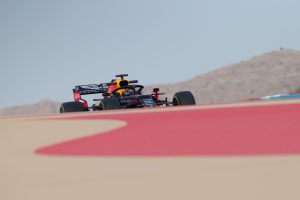Up Next

Formula 1 estimates that qualifying on Bahrain’s perimeter circuit could yield a 53-second lap, which would be five seconds faster than any in the championship’s history.
The championship’s initial indication was the Bahrain Outer circuit, which will be used for the Sakhir Grand Prix as the second part of the circuit’s double-header, would yield a lap time below 55 seconds in qualifying and sub-60s in the race.
F1 technical consultant Pat Symonds has revealed that simulations specifically indicate a 54.3-second lap with two DRS zones and a 53.9-second lap with a third DRS zone.
“In terms of traffic it’s going to be crowded,” Symonds admitted of the 2.2-mile layout. “In the same way, of course, Brazil [Interlagos] gets crowded, short circuits do, but it’s all part of the challenge. And I think to be a complete driver you have to handle things like this.
“The teams have so many tools these days to look at these sorts of things. It will be a challenge, it will be difficult. Maybe someone will lose out from it, someone will gain from it.
“But I think overall we’re going to have a good spectacle.”
Bahrain’s Outer circuit has been under consideration for months, with managing director of motorsport Ross Brawn having admitted long ago the “sort of almost-oval” layout was an option.
But exploring that plan in detail is another matter as it comes with various unknowns, including whether or not the necessary timing loops could be moved and put in place in just a matter of days – as the conventional circuit layout will be used the previous weekend for the Bahrain Grand Prix.
Symonds said that F1 expects it to provide more than just the novelty of a fast qualifying lap, as the championship is anticipating an entertaining 87-lap race – one of the highest lap-counts in F1 history and the most of any race this season.
“We evaluated all the circuits that were available to us,” said Symonds. “Remember, we have some pretty sophisticated tools.
“They’re not just lap simulation tools. They are tools that allow us to look at probabilities of overtaking and things like this.
“Of course, we also looked at tyre duty cycles, brake duty cycles, all these sorts of things. And in this case, we even had to look at lighting because as you’ll have seen from the press release today, it’s going to be a night race rather than a dusk race. We had to ensure that on the outer loop, we had adequate lighting.
“So, we’ve been through all that, we felt that there was something really quite different.
“It’s a very short lap. It’s a very short laptime. It’s a very high-speed circuit. It’s a different sort of challenge, but we’re pretty sure it’s actually going to give quite an exciting race.
“We really want to provide the fans and the spectators with something different and I believe that we’ve done that.”
Bahrain’s Sakhir circuit will be the third place to hold two races this season after the Red Bull Ring and Silverstone.
The Austrian/Styrian GPs were identical in format and details but F1 trialled a softer range of compounds for the second of the two Silverstone races, and that triggered a significant change in form across the grid.
Symonds said the Bahrain experiment was chosen for similar reasons.
“We’ve done a lot of simulation,” he said. “Naturally when we have two races back to back on the same track we’re looking for ways of not just having a carbon copy one weekend to the next and at Silverstone, for example, the idea was to bring the tyre compounds one step softer.
“In Austria, we felt we needed to just have some stability because it was the start of the season. But as we move on to Bahrain, we wanted to look for something else.”





